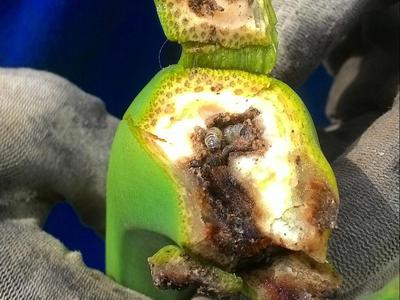Banana Moth
Opogona sacchari
Insect
In a Nutshell
- Feeding damages appear as tunnels on roots, stems, stalks and fruits.
- Plants can be entirely hollowed out.
- Leaves wilt and fall off.
- Premature defoliation.
- Bright brown bodied, 11 mm long moths.
Can also be found in
Symptoms
The infestation can occur during the vegetative growing stage, the flowering stage and also after harvesting. Typically, the adult moths are attracted to damaged and stressed plants. Feeding damage is only due to the larvae, which normally feed on rotting plant material. Having eaten up the residues, they start to feed on the healthy plant material (roots, stems, pseudostems, stalks and fruits). Seeds can be attacked, too. Initial symptoms appear as tunnels, but it is very difficult to spot them in the early stages. Most commonly, the pest is detected at later stages. The fleshy plant parts can be entirely hollowed out and leaves appear wilted. In adverse conditions this might result in defoliation and collapse of the plant.
Recommendations

Organic Control
In greenhouse experiments, the use of nematodes such as Steinernema feltiae, Heterorhabditis bacterophora and Heterorhabditis heliothidis was effective against the larvae. Also bacillus thuringiensis products can be used.

Chemical Control
Always consider an integrated approach with preventive measures together with biological treatments. For a treatment you can use products containing Imidacloprid.
What caused it?
The symptoms are caused by the larvae of the species Opogona sacchari. The moths are nocturnal. They have a bright brown body, are about 11 mm in size and have a wing span of 18-25 mm. Forewings are of an homogeneous brown, with sometimes a long darker banding and males have a dark brown spot on them. The back wings are gray and brighter, with fringes in the margins. The female moth lays around 50-200 eggs in groups of about 5 into wounds and cracks of the plant tissue. After about 12 days the white or pale green, slightly transparent larvae hatch. The larvae have a bright reddish to brown head with an eye-like mark on both sides. The larvae grow to about 26 mm within about 50 days. Then they pupate at the end of the feeding tunnels. After an additional 20 days, the new generation of adult moths hatch. The development is strongly favored in cool temperatures (about 15°C) and dry weather. This period may be reduced under warmer weather conditions.
Preventive Measures
- Use healthy seeds and planting material.
- Regularly check your plants or fields for any sign of the pest.
- Handpick and destroy infected plants or plant parts to curb the infestation.
- Remove and destroy dried out plant material as it can be a source of infestation.
- Ensure careful handling during cultivation and avoid mechanical injuries to the plants.



